Through the courtesy of Ross Mellows and his remarkably comprehensive
web site on camping stoves and other spirit burners, (www.spiritburner.com),
and of Mick Emms and Ted Rawson, the Curator is able to provide some
further examples of Shaw's products in this area.
A report in the "Ironmonger" for 26th September 1914 says that "John
Shaw and Sons of Wolverhampton are placing on the market a full range of
wickless blow lamps, all of which are of English manufacture".
They go on to provide details of the range, which includes the
"Anglo-Swedish". All of this suggests that the British market had
been dominated by Swedish made blow lamps and Shaws were trying to grab
back some of that market. The report also gives us an approximate
date for the the first manufacture of these lamps - 1914. But a
Shaw advert in the "Ironmonger" for 17th October 1914 says that "our
'Governor' lamps are not an experiment; we have been supplying them to
the complete satisfaction of large and experienced buyers, therefore
there is positively no need to import". In another Shaw advert in
the same magazine for 21st June 1919, they say "we have been making them
for over six years". So it seems that Shaws may have started in
this line in 1913, selling direct to large users and then marketing them
generally in 1914.
 |
This advert from the "Ironmonger" of 1914 shows "a
few only of the lamps we have ready for delivery". It asks
ironmongers whether they are "having any difficulty in obtaining
supplies of continental blow lamps". If they were having
difficulty in October 1914, they would soon be having even
greater difficulty. It seems likely that Shaw's had struck
lucky with the timing of their introduction of their British
made blow lamps - though it is still advisable to mention that
they are of "continental patterns". The lamp bottom left
is marked "Anglo-Swedish".
The date at which Shaws bought out the Lamb Lamp Co. is not
known but two of these lamps are marked "Lamb Lamp", suggesting
that the company had been acquired by 1914. It may just be
that Shaws acquired Lamb for the purpose of getting their range
of lamps and their expertise.
|
| This advert from 1921 boasts about their design
being adopted generally during WW1; but it also has to
acknowledge that Swedish made torches and stoves had a well
established market which Shaw's were chasing. |
 |
 |
This advert comes from 1922. What we think
of as camping stoves were used - or at least Shaw's hoped they
would be - far more widely, as a cheap general purpose cooking
apparatus. |
| This advert comes from 1923. Since it seems that
Shaws had acquired the Lamb Lamp Co. by 1914 at the latest, it is
interesting to note that they continued the use of the Lamb name
certainly as far as the 1939 catalogue. |
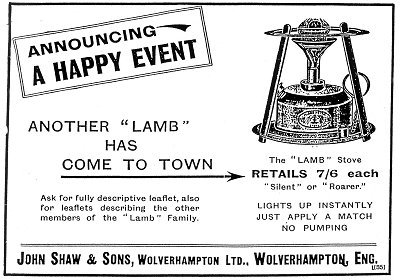 |
|
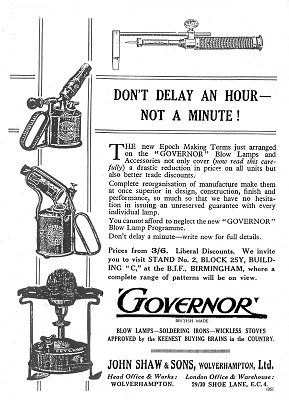
|
This advert comes from 1928. It draws attention to
"a drastic reduction in price on all units" and "better trade
discounts". One suspects that this is a response to the Great
Depression and a general downturn in trade.
[The reference to their exhibit at the B.I.F., Birmingham, is to
the British Industries Fair, and annual event, promoted by the
Government, and held both in Birmingham and London].
|
| The Lamb petrol stove will burn petrol, benzoline or
naptha. (The Governor used paraffin). It "requires no
pumping, lights up automatically" and has "an indestructible metal wick
- this is an exclusive feature). The box has a fall front and a
hinged lid, so you can prop your pots and pans straight on top without
taking the stove out of its "attractively finished" gold and black box. |
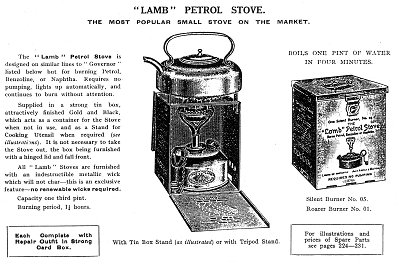 |
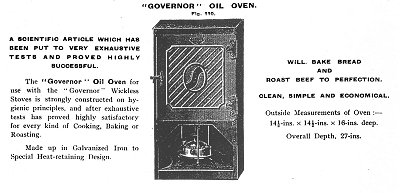 |
The Governor Oil Oven shows again the use of these
stoves in a domestic or other non-camping context. The
Lamb version was smaller and cheaper - and needed a separate Governor
stove to go underneath it. |
| The Bijou is a collapsible version of the Governor
stove. |
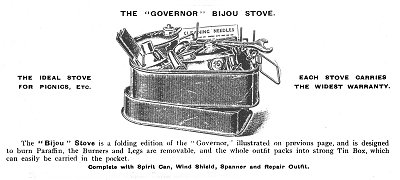 |
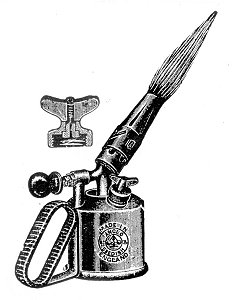 |
This and the following exhibits come to us through
the courtesy and generosity of Mick Emms and Ross Mellows who,
between them, provided us with a copy of Shaw's catalogue which
is undated but seems to date from the late 1920s or possibly
1930-31.
This is the Anglo Swedish lamp for petrol, benzoline or
naptha. The caption boats that "The flame tube is in one
peice, not two - as in Continental lamps" |
| This alarming looking device is the Governor
Engine lamp. It burns paraffin or petrol and will be found
"useful where large quantities of metal are to be melted". But
"as its name implies, this Lamp is primarily made for starting
up Oil engines" and has "a large and exceedingly hot flame". |
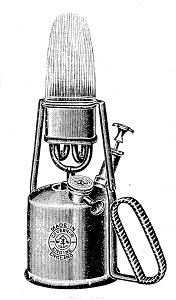 |
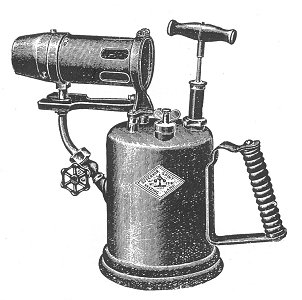 |
This sturdy beast is the Governor Brazing Blow Lamp.
Its length of flame is 12 to 14 inches, the flame having a diameter, at
the mouth, of 1 5/8ths inches. Not surprisingly "one inch of solid
copper can be melted in about five minutes".
The caption also says: "The above Lamp resembles in many
respects a well-known Lamp of Continental manufacture but has
certain important advantages. The Body of the Continental Lamp
is made from seamed tubing with soldered top and bottom - more like
a stove pipe than a blow lamp". But the Governor is drawn from
a solid piece and is brazed - which means that you do not have to
follow the advice of the Continental manufacturer and keep the lamp
away from heat. |
| Of course soldering was cheaper and easier and still
almost universally used in all those cases where nowadays we would opt
for welding. This soldering outfit includes a combined torch and
soldering iron and everything else you need and comes in a metallic box. |
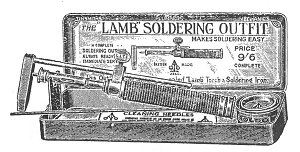 |
 |
But the amateur wireless enthusiast - much commoner then
than now - only gets a plain soldering iron, a bar of solder and a tin
of flux - and only a cardboard box, which does at least have "full
directions for use " printed on it. |
The following are from the 1939 catalogue.
| The exhibit here is the Governor petrol Blow Lamp
with the pump incorporated in the handle. It produces
"intensely powerful concentrated heat" and is therefore suitable
for "use outdoors in the roughest weather".
There are also two combination soldering irons and blow
lamps, both petrol driven, and one said to be "a very handy tool
for Wireless Work". |
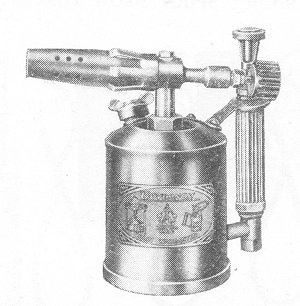 |
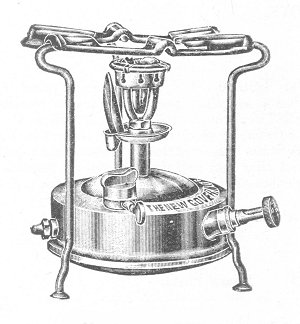 |
This is the Governor Wickless Stove, which came in
two types: the Roarer and the Silent. This is the Roarer.
The only difference appears to be in the design of the burner -
the silent having many more apertures. Presumably it was
quieter but less efficient. The catalogue also shows some
Villiers Petrol Stoves. |
| This is the Lamb Laboratory Lamp, from the 1939
catalogue. The catalogue says it has been specially designed for
all work in the laboratory and that it is specially designed for County
Area Schools - where, presumably, a gas supply is less likely to be
found.
A review of the lamp in the Ironmonger for 1926 (kindly supplied by
Spiritburner), accompanied by an identical drawing, suggests that
this was new at the time. The three burners are a circular
roarer, a bunsen burner and a fish tail burner. |
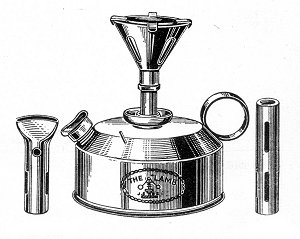 |
 |
Return
to the
previous page |
|

